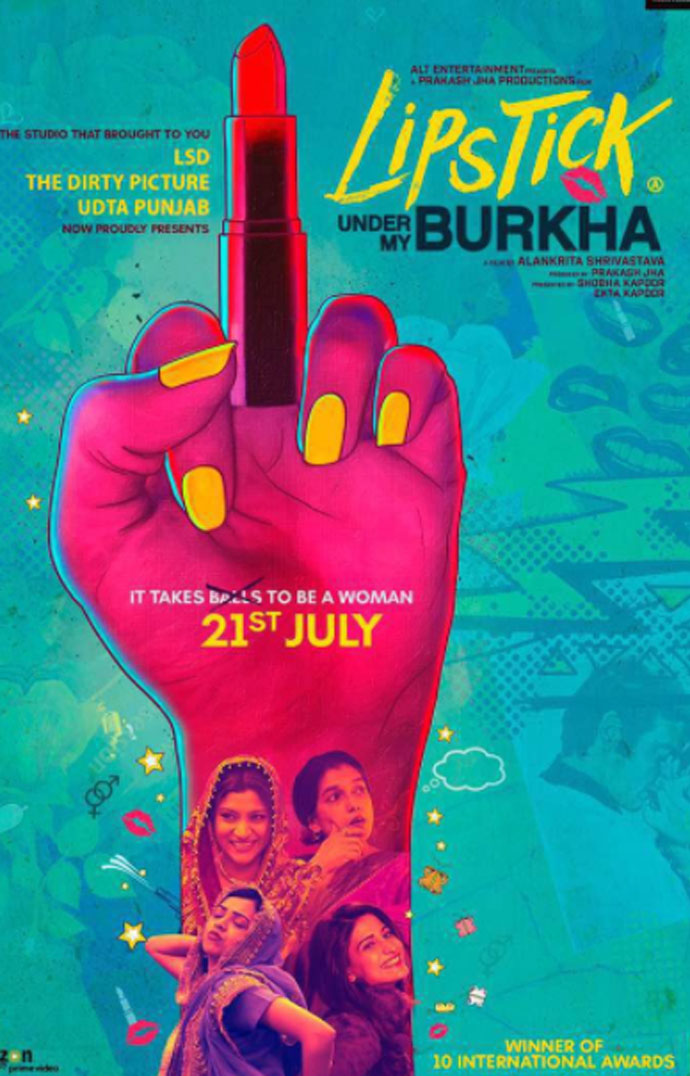Why Lipstick Under My Burkha is a watershed moment for Bollywood

The struggle that our film makers face in releasing films may seem distant to an Indian writer writing in English. For in our fiction and poetry, our writers have pushed boundaries and gotten away with so much.
One can write graphic scenes and no one makes an issue out of it. When one shows this in cinema, one comes up against an out of sync censor board, which, in the twenty-first century, clings to the belief that our vernacular audiences need to be protected from their own realities.
Alankrita Srivastava’s Lipstick Under My Burkha is a bold biting film about the inner (and outer) lives of four women who live in old Bhopal. These are women at different stages of their lives: one is married (Konkona Sen Sharma), one is engaged against her will and about to get married (Ahana Kumra), another has just started on college (Plabita Borthakur), and there’s Buaji, a 55-year-old widow who owns a sweet shop.
This is such a good film that to analyse it scene-wise, so close to its release, would be unfair to the audience and the filmmaker. I wouldn’t give a hint away. It’s perhaps also one of those films that needs to be seen twice. Only then does one appreciate the thick detail, the turns and twists, how the balance of power shifts constantly in a sexual relationship.
We put up a front for the world, but underneath it lurks a maelstrom of secret desire and ambition. You can lock a woman into the stereotype of wife, daughter or a greying lady who attends satsangs, you can put her in a cage, but you cannot stop the mind from exploring its hidden corners. The bird might be confined, but that doesn’t stop it from flying the high blue skies, dark clouds on the horizon.
Lipstick is four stories in one, a device that allows it explore a range of characters; the narrative criss-crosses these four lives with an astonishing assurance. It’s a film built on contradiction. At any given moment there’s a lot of happening, but there’s also a kind of reflective stillness hanging over each manic scene.

Black blends into white and still, at times, the colours paradoxically retain their identity even as they bleed into each other. It’s a film about the rapidly changing present; it’s also about the past clinging doggedly to its roots, even as the giant oak of tradition is gradually uprooted, perhaps even transplanted.
The women in this film are not asking for much: they want to take swimming lessons, put on some make-up, wear jeans, go out in the world, make money and be independent. They want to have sex, on their own terms, with who they like. It’s a short life. We should have the freedom to lead it without deception, without the fig-leaf of a lie.
While I watched this film of stories, I found myself thinking about my favourite women story writers. American author Grace Paley, a master of the short story, was famously against the variety of literature that believes in plot and character development.
There is plot and character development in Lipstick but the stories are also left open ended, as they should. For, as Paley said, “Everyone real or invented, deserves the open destiny of life.”
Mary Miller, a luminous new voice in American short fiction, has this to say of the story form: “A story works when there's momentum, life behind the words. Some stories have this and others don't, and it's difficult to say why this is. If all stories 'worked,' though, writing wouldn't be much of a challenge; it wouldn't be art.”
Every single story in Lipstick has tremendous momentum—life leaps at you from the big screen, so much so that the characters follow you out of the movie theatre, and trail you as you walk the by lanes of your own small town, in my case Dehradun, also the town where the director of the film went to school in.
A word about Ratna Pathak Shah, who is enjoying a well-deserved renaissance of sorts. It started with Kapoor & Sons, continued with Neel Battey Sannata, where she plays a friendly memsahib to Swara Bhaskar’s maid, and now this virtuoso performance – precise, playful, and passionate – in Lipstick. The naughty Buaji is the strongest character in the film; Shah takes this character and gives it flesh, blood and a big pumping heart.
Finally, this film rips the veil off the Hindi-speaking Indian bedroom. English-speaking India often wonders what it’s like because the rest of us imagine we speak like characters in a Netflix show. I would love to see the uncut version — the one we can have been stabbed and slashed twenty-seven times.
Lipstick, for me, is now lodged in my all-time list of cult classics. I love it the same way I love Chashme Baddoor or Satya or Pulp Fiction or that other lady-oriented film, Elizabeth Wood’s 2016 directorial debut, White Girl, about an Oklahoma girl’s cocaine and sex-fuelled coming-of-age journey through an unrelenting New York City.

